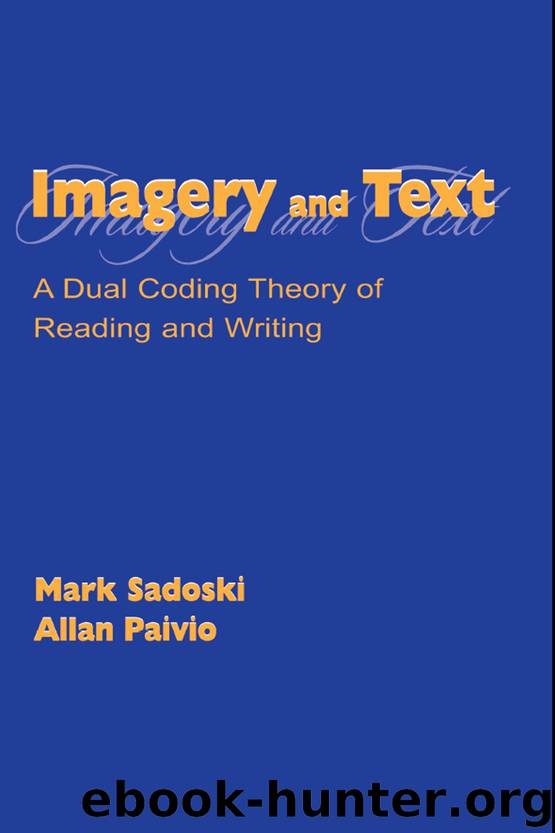Imagery and Text by Sadoski Mark. Paivio Allan

Author:Sadoski, Mark.,Paivio, Allan.
Language: eng
Format: epub
Publisher: Taylor & Francis Ltd
DCT AND CONTEMPORARY THEORIES OF THE READING PROCESS
DCT is an overall theory of cognition that encompasses all the phenomena covered by theories designed more specifically for the reading process. Contemporary theories of the reading process are interactive. Although articles and textbooks in the field often categorize theories as bottom-up, top-down, and interactive, such a categorization derives from the type of processing emphasized by a theory and can be misleading.
Purely bottom-up theories of the reading process have been proposed (e.g., Gough, 1972; LaBerge & Samuels, 1974), but have been subsequently discounted (e.g., Gough, 1985) or modified to render them interactive (e.g., Samuels, 1977). These bottom-up theories held reading to be a serial process beginning with graphic input from the page, visual encoding, and phonological receding of the visual encoding, before any higher order processes such as syntactic and semantic interpretations occurred. Considerable evidence from eye movement research (e.g., Just & Carpenter, 1980; Paulson & Goodman, 1999; Rayner, 1997; Rayner & Pollatsek, 1989), neurophysiological studies of reading (e.g., Holcomb et al., 1999; Kounios & Holcomb, 1994; Kutas, 1993; Van Petten, 1993; West et al., 1998), as well as behavioral studies (e.g., Rumelhart, 1977), has rendered such an approach untenable, primarily because higher-order processes have been shown to affect lower order processes.
Interactive theories maintain that processing at one level of analysis can affect processing at another level, so that top-down processes can affect bottom-up processes and vice versa. Thus, how we respond to print is influenced by prior knowledge of language, prior knowledge of the content of the text, situational contexts associated with the reading, and the context arising from previously interpreted parts of the text, as well as the print itself. In the following sections, we will show how DCT explains bottom-up and top-down phenomena in the reading process.
Download
This site does not store any files on its server. We only index and link to content provided by other sites. Please contact the content providers to delete copyright contents if any and email us, we'll remove relevant links or contents immediately.
The Art of Coaching Workbook by Elena Aguilar(50990)
Trainspotting by Irvine Welsh(21520)
Twilight of the Idols With the Antichrist and Ecce Homo by Friedrich Nietzsche(18504)
Fangirl by Rainbow Rowell(9098)
Periodization Training for Sports by Tudor Bompa(8171)
Change Your Questions, Change Your Life by Marilee Adams(7636)
This Is How You Lose Her by Junot Diaz(6796)
Asking the Right Questions: A Guide to Critical Thinking by M. Neil Browne & Stuart M. Keeley(5646)
Grit by Angela Duckworth(5525)
Red Sparrow by Jason Matthews(5391)
Paper Towns by Green John(5092)
Room 212 by Kate Stewart(5040)
Ken Follett - World without end by Ken Follett(4646)
Housekeeping by Marilynne Robinson(4348)
The Sports Rules Book by Human Kinetics(4295)
Double Down (Diary of a Wimpy Kid Book 11) by Jeff Kinney(4208)
Papillon (English) by Henri Charrière(4199)
The Motorcycle Diaries by Ernesto Che Guevara(4015)
Exercise Technique Manual for Resistance Training by National Strength & Conditioning Association(3957)
